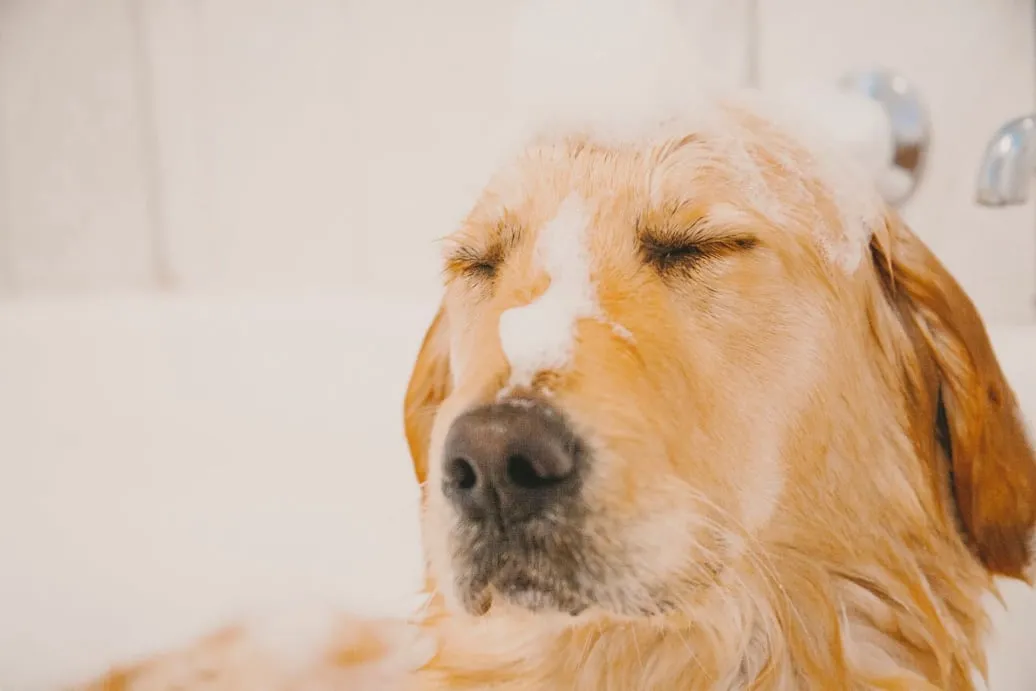

Some dogs, like people, have sensitive skin that requires extra care—especially during a dog wash or bath. If your pup is prone to itching, flaking, or redness after being washed, it's a sign that their routine needs a gentler approach.
Here are four key tips to ensure your dog bath is safe, soothing, and skin-friendly:
The foundation of any bath service for a sensitive-skinned dog is the shampoo. Avoid products with harsh chemicals, artificial fragrances, and sulfates, which can strip natural oils and aggravate the skin. Instead, choose hypoallergenic, pH-balanced formulas that cleanse gently while soothing irritation.
It is recommend to choose:
- Oatmeal or aloe-based dog bath products
- Hypoallergenic shampoos formulated for dogs
- Coconut-infused or pH-based dog wash shampoos
These provide a gentle yet effective clean that won't irritate sensitive skin.
Water that's too hot or too cold can worsen sensitive skin symptoms. Always wash your dog in lukewarm water for maximum comfort.
Post-bath drying tips:
- Use a soft towel to blot-dry rather than rub
- Keep dryers on low or cool settings to prevent further irritation or overheating.
- Avoid high-velocity dryers, especially for dogs with flare-ups or allergies
A calm and comfortable drying process is essential for a safe dog wash experience.
Residue left behind after a dog wash can be one of the most common causes of itching or irritation. Always take extra care to rinse your dog thoroughly, especially in folds and under joints.
Avoid scrubbing, which can inflame the skin barrier. A gentle rinse is just as important as the shampoo itself in a successful dog bath routine.
Not every dog needs the same grooming and wash frequency. For those with sensitive skin, too-frequent bathing can actually do more harm than good, while under-bathing may allow buildup that worsens discomfort.
Recommended dog wash frequency:
- Mild sensitivity: Every 4–6 weeks
- High sensitivity: As needed or under veterinary advice
Short haircuts and proper coat maintenance can also reduce skin irritation between dog baths by preventing mats and hotspots.
Recognizing the signs of skin irritation early can help prevent minor discomfort from turning into a more serious issue. Whether it's a new product, improper rinsing, or over-washing, sensitive skin often reacts in visible and behavioral ways.
Common signs to watch for include:
- Excessive scratching or licking, especially right after a bath
- Redness, rashes, or small bumps on the belly, paws, or underarms
- Dry, flaky skin or dandruff-like particles in the coat
- Hot spots or inflamed patches that seem painful to touch
- Hair loss or thinning fur in localized areas
If your dog exhibits any of these symptoms after a wash, it's a good idea to adjust their grooming routine and consult a veterinarian for advice. Tailoring your dog's bath products and frequency can significantly reduce these reactions and support ongoing skin health.
For dogs with sensitive skin, a stress-free environment can make a world of difference. Learn more about the professional mobile dog wash & bath service Fur Sure Grooming offers!
How often should I wash a dog with sensitive skin?
For dogs with mild sensitivity, wash every 4-6 weeks. For high sensitivity, wash as needed or under veterinary advice. Too-frequent bathing can actually do more harm than good for sensitive skin.
What type of shampoo should I use for dogs with sensitive skin?
Choose hypoallergenic, pH-balanced formulas. Look for oatmeal or aloe-based products, hypoallergenic shampoos formulated specifically for dogs, or coconut-infused shampoos. Avoid products with harsh chemicals, artificial fragrances, and sulfates.
What are signs of skin irritation after a dog bath?
Watch for excessive scratching or licking, redness or rashes on the belly/paws/underarms, dry flaky skin, hot spots or inflamed patches, and hair loss in localized areas. If these symptoms appear, adjust the grooming routine and consult a veterinarian.
What water temperature should I use for washing a dog with sensitive skin?
Always use lukewarm water. Water that's too hot or too cold can worsen sensitive skin symptoms and cause discomfort for your dog.
Professional grooming is more than just a luxury—it's a smart investment in your pet's health. Discover how trusting the Pros Can Make a Big Difference for Your Dog during grooming.
When it comes to canine grooming, many pet parents are unsure what services their dog needs—whether a full-body haircut is essential or a simple bath and brush. Here's how to choose the right grooming option.
Regular grooming has been shown to boost dogs' confidence, calmness, and overall temperament, making it more than just a cosmetic routine. Discover how regular grooming can transform your dog.
Join Our Fur Sure Family!